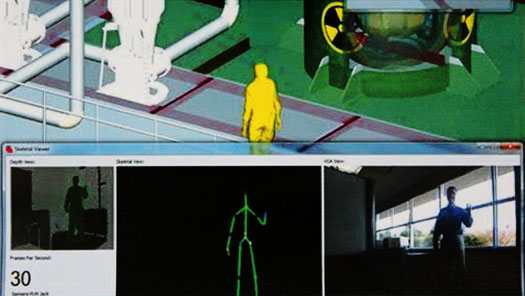| Jul 17, 2013 |
Kinect makes dangerous work processes safer
|
|
(Nanowerk News) Siemens is using a Microsoft Kinect sensor familiar from computer games in a virtual planning system for work processes. Kinect technology recognizes a person's movements and posture and transfers them to an avatar in a virtual environment. In the same way that a player moves intuitively within the scenes of a computer game, technicians can use Kinect to simulate movements in the workplace. In its Product Lifecycle Management Software, Siemens Industry already provides interfaces to systems that precisely measure people's movements. Because such solutions are frequently complex, however, Siemens has now developed a version based on the Kinect sensor that is more user-friendly, although not as precise. The new solution makes the system available for other industrial applications, such as the planning of dangerous tasks.
|
 |
| Siemens is using a Microsoft Kinect sensor familiar from computer games in a virtual planning system for work processes. Kinect technology recognizes a person's movements and posture and transfers them to an avatar in a virtual environment. In the same way that a player moves intuitively within the scenes of a computer game, technicians can use Kinect to simulate movements in the workplace. (©: Microsoft Corp.)
|
|
Only a few major industries currently use systems that digitally track movements. The automotive industry is one example, which employs such systems to make assembly line workplaces more ergonomic or to design vehicle interiors. With the help of multiple cameras, electromagnetic sensors or full-body suits, the systems can measure the movements of people wearing special markers to within a single millimeter. The technology is complex and can only be operated by appropriately trained staff. To develop a simpler system based on Kinect technology, the engineers from Siemens had to appropriately process the data. Although the Kinect sensor recognizes movements, it doesn't measure them precisely. That's why the developers use libraries containing simulation models for typical movements and combine these models with the information supplied by the Kinect sensor.
|
|
The first application to be created was a solution for planning service and maintenance work at nuclear power plants in the U.S. The application aims to ensure workers are exposed to a level of radiation that is as low as reasonably achievable (ALARA). To do this, technicians or planners operate the Kinect sensor-equipped simulation program and carry out specific work within a virtual environment. In reality, these environments would be exposed to radiation due to radioactivity. The program calculates the radiation dose that the virtual technician receives. The system helps the planners vary the individual work steps and the design of the workplace in order to reduce the dose to the lowest reasonably achievable level. Similarly, the system could also be used to plan work in chemically contaminated environments or to conduct traditional ergonomics tests.
|

